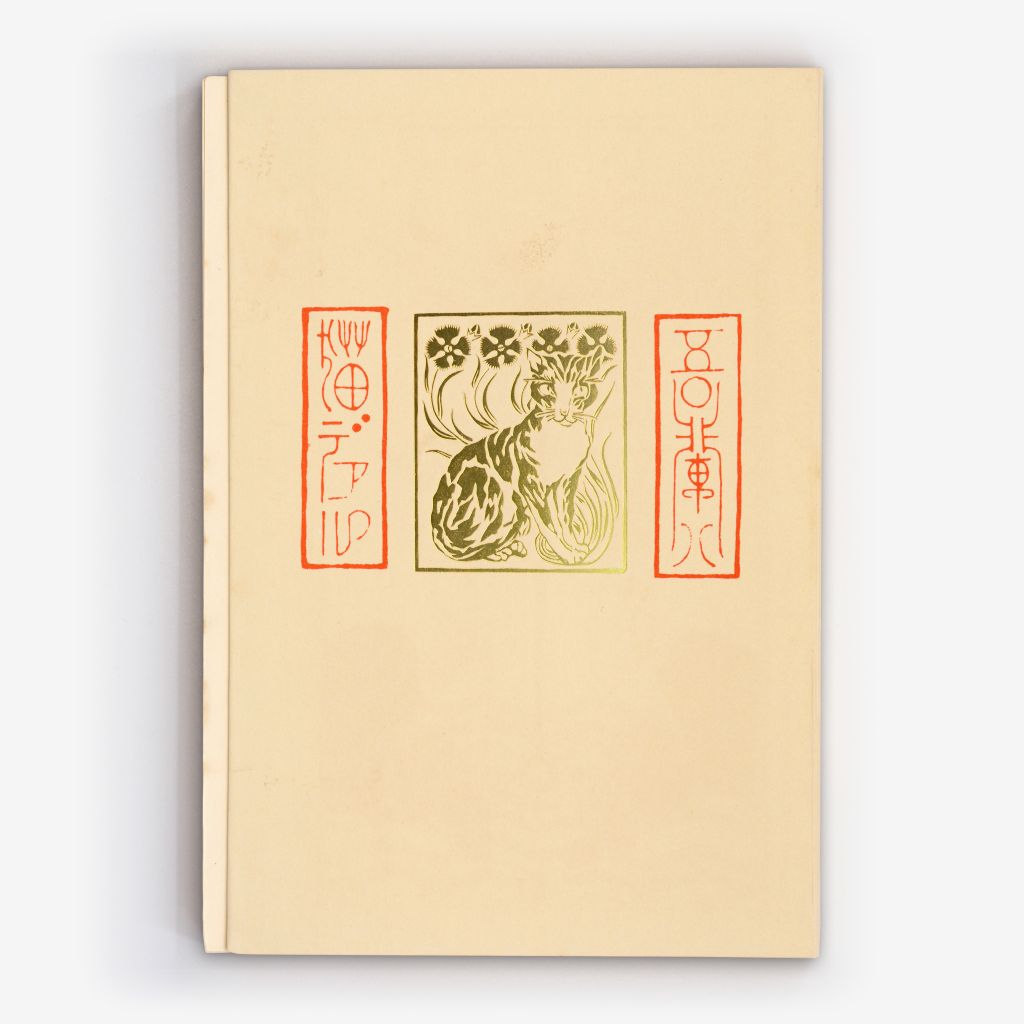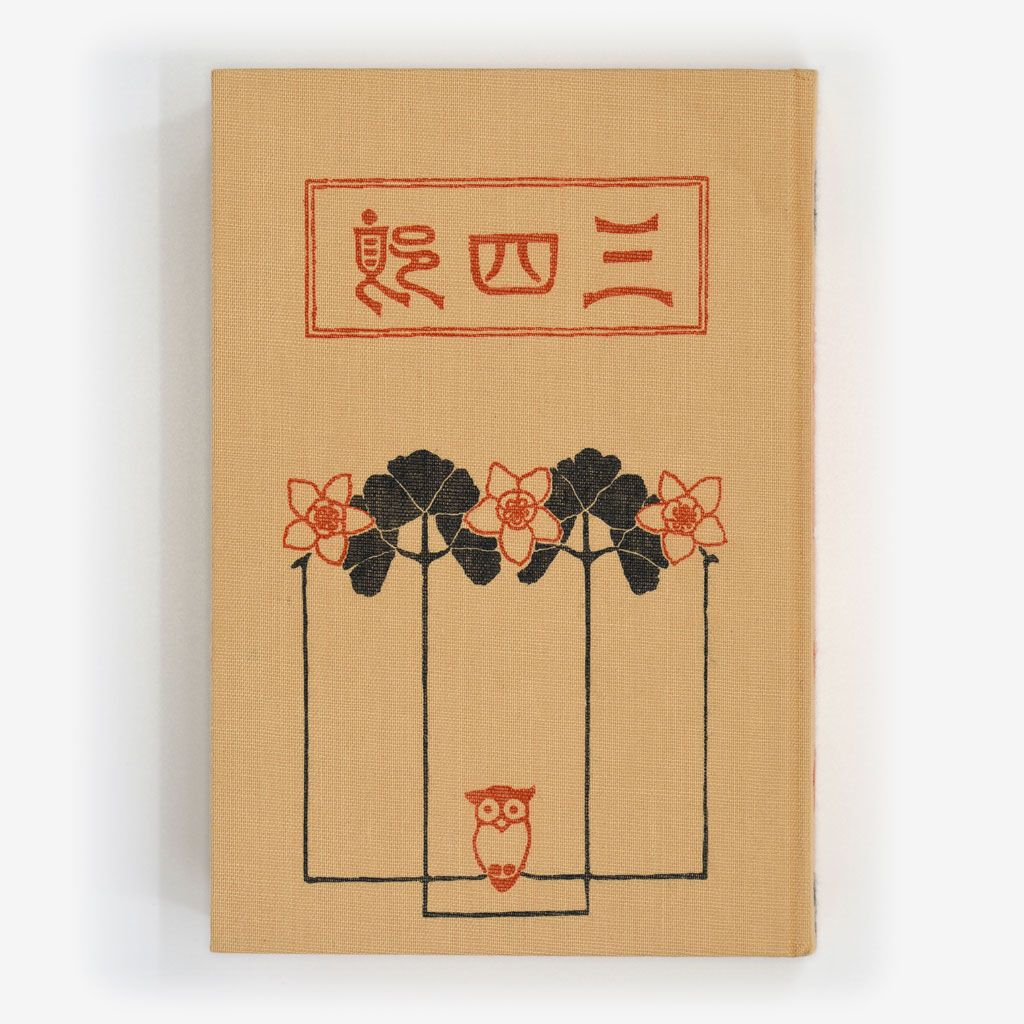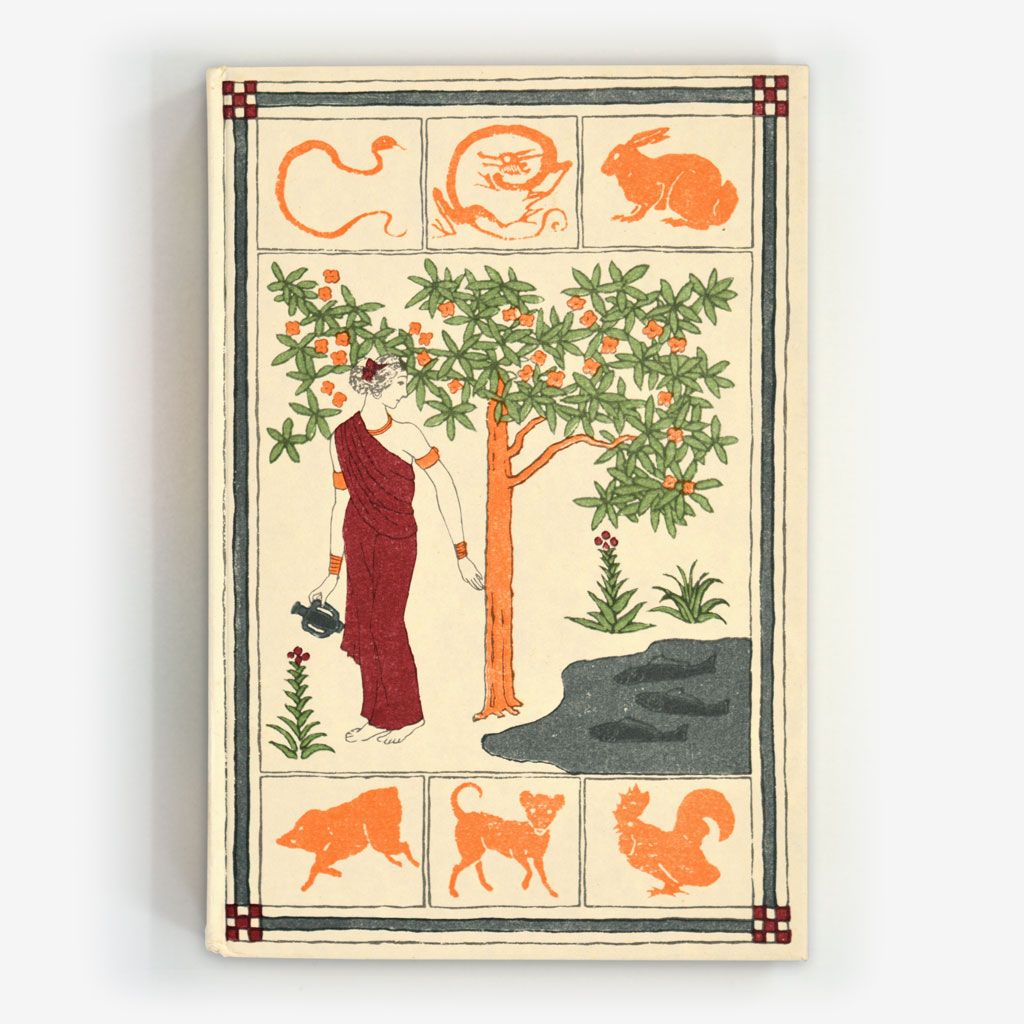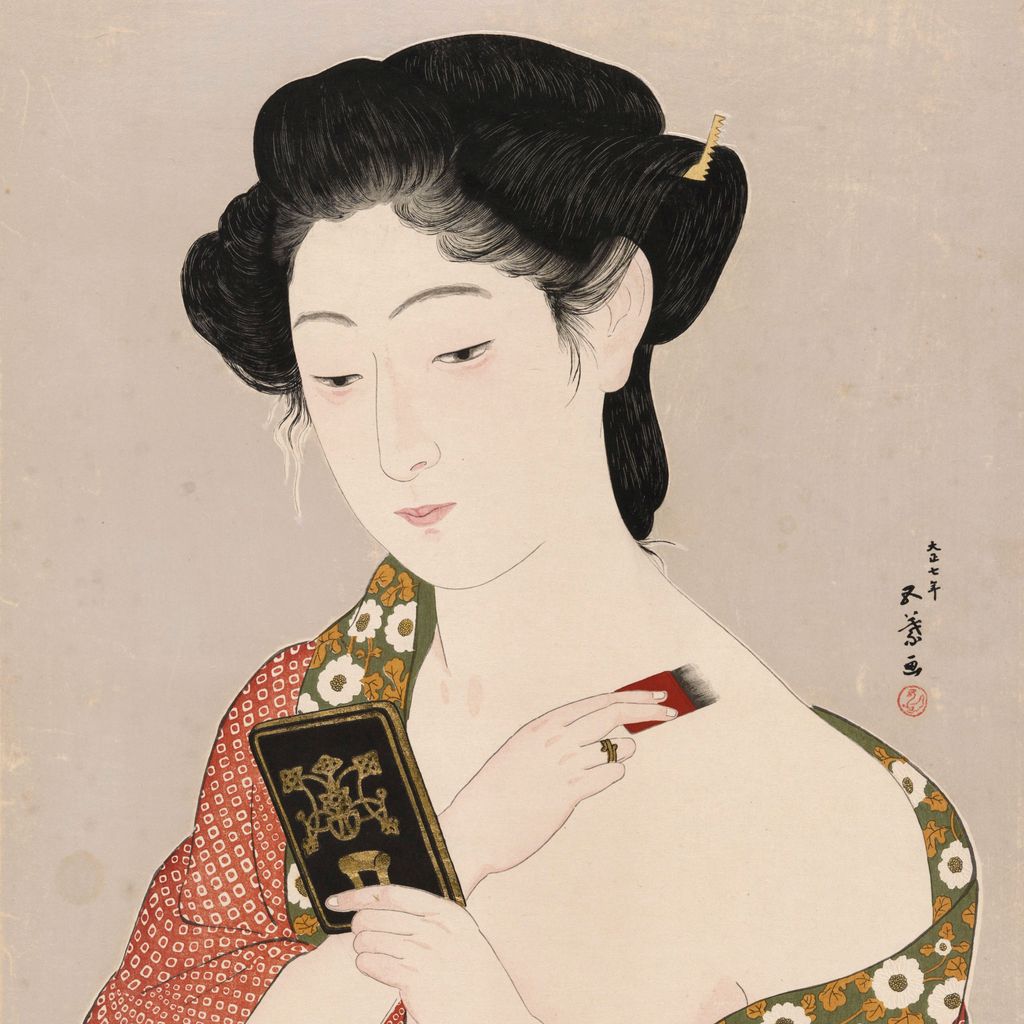Hashiguchi, Goyō
橋口五葉
Japanese Painter, Printmaker and Graphic Designer1880–1921

Hashiguchi Goyō was a painter, printmaker and book designer active in the early 20th century. He was a sought-after bookbinding artist, designing books for renowned novelists. Goyō published research and reproductions of early woodblock print masters and pioneered the Shin-hanga print movement. In his later years, Goyō created and self-published superbly produced woodblock prints of beautiful women, for which he is celebrated beyond his early death.
Goyō was born in 1881 (Meiji 14) as Hashiguchi Kiyoshi in Kagoshima, located on the island of Kyushu in the southern part of Japan.
He was the third son of his father, Kanemitsu, and mother, Yoshi. Goyō was one of four siblings: two older brothers and a younger sister, and they were all close to each other. His father was once an official doctor (as a Chinese herbalist) for the Shimazu family in Satsuma. However, this role lost its importance after the abolition of feudal domains and the establishment of prefectures, so he retired. The three brothers were strongly influenced by Kanemitsu, who was fond of calligraphy and enjoyed painting in the style of the Shijō school.
Education and Early Works
Growing up in a family with an affinity for the arts, Goyō began painting early on. From the age of 13, he studied under local Kanō school painter Uchiyama Jōsuken Ikkan.
In the summer of 1899, after he graduated from Kagoshima Junior High School at the age of 18, Goyō moved to Tokyo to study under Hashimoto Gahō, one of the last artists to paint in the Kanō school style.
In April 1900, he exhibited three Japanese-style paintings at the 8th Kaiga Kyōshin-kai (Society for Competitive Exhibitions of Paintings). This is believed to be the first time that he officially used his art name, “Goyō.”
However, Goyō eventually turned to Western-style painting at the recommendation of the Western-style artist Kuroda Seiki, a distant relative from Kagoshima. In September of 1900, he took a preparatory course at the Tokyo Fine Arts School, and the following year, he enrolled in the main Western painting course at the same institution.
At school, Goyō interacted with artists of the Hakuba-kai (the White Horse Society), formed by Kuroda Seiki, and exhibited three Western-style oil paintings at their exhibitions in 1902 and 1904.
Starting in 1904, he began to contribute illustrations to the literary magazine Hototogisu, at the recommendation of novelist Natsume Sōseki, who published his writings there.
This key career opportunity was facilitated by Mitsugu, Goyō’s eldest brother, who introduced Goyō to Sōseki. Mitsugu had been a student of Sōseki when the latter was teaching English at Kumamoto Fifth High School, not far from their hometown in Kyushū.
Book Design
Teacher and disciple would later reunite when they both lived in Tokyo, occasionally meeting at Mitsugu’s house for conversations about art. Goyō, who had lived with his brother since moving to the capital, would join in. On these occasions, Sōseki would take notice of Goyō’s talents.
Sōseki, who had recently begun to serialize his first novel, Wagahai-wa neko de aru (I Am a Cat), in the Hototogisu magazine, introduced the young painter to his publisher. Notably, Goyō was 15 years younger than Sōseki and still a student at the Tokyo School of Fine Arts. Nevertheless, Goyō was commissioned as an illustrator, and his work was well received.
Sōseki must have felt that Goyō’s whimsical brushwork might be a good fit for his satirical novel, as he invited him to draw for I Am a Cat. Beginning with the October 1904 issue of Hototogisu, Goyō contributed illustrations for subsequent installments of the novel until 1906.
While the serialization was still ongoing in the magazine, the first volume of I Am a Cat was to be published in book form in 1905. Sōseki asked Goyō to design the bookbinding, sending his request by postcard: “As for the front cover, please create something from thick, eggshell-colored vellum paper with vermillion and gold…”

Goyō fulfilled Sōseki’s request and then some, further developing the design and bookbinding and elevating the product to a comprehensive work of visual art. The front cover featured a vermillion cat and a title with gold leaf stamping. The bookbinding was a case-bound book with a flat back and a gilt top. One side of the book was uncut, meant to be opened with a paper-knife as it was read. The result was a luxurious bound book for those days.
Following I Am a Cat, the collaboration between the two continued until 1914, ultimately totaling seventeen books.
The connection with Sōseki opened opportunities for Goyō to design books for other novelists, including Izumi Kyōka, Mori Ōgai, Nagai Kafū, Tanizaki Junichirō, Yosano Akiko, and many others. Goyō became a sought-after book designer, creating more than one hundred books during his career until 1920, the year before his death.
The most characteristic feature of Goyō’s book designs are the patterns of flowers, insects, fish, and birds, which are then framed by flowing curves or combined with other ornamentation. The influence of Art Nouveau is clear; more remarkably, he not only borrowed foreign forms but digested them until they became a natural part of his artistic expression.
Indeed, Goyō was one of Japan’s early pioneers of modern graphic design, skillfully combining Japanese and Western aesthetics and modern bookbinding techniques.
Goyō expressed his thoughts about designing books as follows:
“The most artistic aspect of binding books is apparent when a bookbinding artist is not controlled by the materials but rather expresses his artistic purpose, and when the bookbinding artist can express his taste strongly, so he should make good use of the form of bookbinding: the stitching; the relation of the front and back; the lettering, illustrations and design; and the materials, namely leather or cloth and paper, and the relation these all have to plate-making and printing.”
Painting

Parallel to designing books, Goyō continued to create oil paintings, many of which were studies from his days at art school.
He developed an approach combining the realistic expression of Western-style paintings, the flatness of Art Nouveau, and the stylized renderings of Japanese painting — showing influences from the compositions and moods of the Pre-Raphaelites and a fascination with ancient mythology.
Some of these paintings were publicly exhibited. For example Kujaku to indo on'na (Peacock and Indian Woman) at the Tōkyō Kangyō Kakurankai (Tokyo Industrial Exhibition) in 1907, and Hagoromo (Feather Mantle) at the first Bunten exhibition held in the same year. However, he gradually gave up oils after his works repeatedly failed to be accepted by Bunten’s admission jury in subsequent years.
In addition to losing self-confidence in oil painting, he suffered from health issues that would plague him for the rest of his life. In the summer of 1910, Goyō traveled to Beppu in Oita Prefecture — a region famous for its spas and located on the same island of his birth — to recover. His visits to the hot springs and the beautiful landscapes inspired his creative direction in the following years. Sketches from this trip eventually formed the basis for his later woodblock prints.

But before this, his “last attempt” at oil painting in 1911 proved to be a huge success. In February of that year, Goyō entered a Western-style oil painting, Kono Bijin (This Beauty), for an advertising competition sponsored by Mitsukoshi Kimono Store. It won first prize out of 300 submissions. The prize money of 1,000 yen, an unprecedented amount at the time, attracted much public attention. Goyō’s painting was reproduced as a lithograph poster and hung at over 500 train stations across Japan. In the advertising industry, this event marked a turning point from the era of illustrated leaflets to using posters as a popular medium to promote products.
Aligned with Mitsukoshi’s clientele, “the modern woman,” the poster’s aesthetic — as well as its subject, who wore her hair in the then-fashionable "203 Kōchi" style — reflects the trends of the time. Like in his earlier paintings, Goyō naturally combines realistic depictions and stylized elements. The composition draws on the classic Bijin-ga theme, or “pictures of beautiful women,” prevalent in Nihon-ga paintings and Ukiyo-e prints. Notably, the subject holds a picture book of woodblock prints, which hints at one of Goyō’s great passions.
Woodblock Prints
Goyō had been trying to shift away from oils for some time, searching for a new medium to spark his creativity. Invigorated by the poster’s positive reception and perhaps liberated by the prize money, he turned his attention to woodblock printing.
Goyō went on to a period of extensive research into the techniques of Ukiyo-e printing and started to publish many articles on the subject, mainly on the classic works of Utagawa Hiroshige and Kitagawa Utamaro.
Along with his research, Goyō painted watercolor studies inspired by his travels in Oita and began experimenting with creating his own woodblock prints.
In 1913, the watercolor painting Onsen, depicting a scene at a hot spring, was exhibited at the National Art Association’s 1st Western Art Exhibition. In the subsequent two years, he completed two woodblock prints, both published as frontispieces of the literary magazine Shin Shōsetsu (New Novel).
In response to these activities, he was approached by the publisher Watanabe Shōzaburō in 1915, who was looking to commission a suitable artist for his woodblock printing project that would later evolve into the Shin-hanga movement. Watanabe was looking to “revive” the art of woodblock printing with a modern approach and contemporary artists.

Goyō was persuaded and designed the print Yokujō no on'na (Woman After the Bath). The print was executed in the traditional cooperative system, where at least three expert artisans — a designer, carver and printer — collaborate under a publisher’s direction. After a series of experiments at Watanabe’s workshop, the work was released the following year as a limited edition of 100 prints. Today, Yokujō no on'na is now acknowledged as the first Shin-hanga print.
However, Goyō appeared to be dissatisfied both with the result and with his collaboration with Watanabe. Watanabe wanted to continue the partnership, but Goyō chose to take a step back to improve his skills and reassess his approach to woodblock prints.
He embarked on another period of careful research into the techniques of Ukiyo-e printing. Between 1917 and 1919, Goyō supervised three series of print reproductions of early Ukiyo-e masters — over 300 individual woodblock reproductions in total, published together with essays and commentaries that he penned.
In March 1918, two years after he collaborated with Watanabe and a period of creating sketches and studies, Goyō self-published his first woodblock prints, including Yabakei (Yaba Gorge) and Keshō no on’na (Woman Applying Makeup).

He continued to be very prolific over the following two years. By 1920, he had remarkably self-published ten prints, including the work he is probably best known for, Kami sukeru on'na (Woman Combing Her Hair).
Early Death and Posthumous Publications
The accumulated fatigue from this production proved to be fatal. By the late 1920s, Goyō’s health was in rapid decline. He supervised his last print, Onsen Yado (Hot Spring Inn) from his hospital bed, and died on February 24, 1921, at the age of 41.
Goyō left behind several unfinished print designs upon his early death. His elder brother and nephew later commissioned the production of a selection of prints based on the works.
Goyō’s impressive legacy ranges widely from painting and book design to writing about Ukiyo-e and publishing reproductions of early woodblock print masters. He managed to blend traditional and modern techniques with Japanese and Western aesthetics into his own vision. He eventually played a key role in revitalizing the woodblock print medium through his works, which have established his reputation as one of the greatest of the Shin-hanga artists.
Details
- Family Name
橋口
Hashiguchi
- Given Name
五葉
Goyō
- Born
December 21, 1880
Kagoshima, Japan
- Died
February 24, 1921
Tokyo, Japan
- Gender
- Male
- Nationality
- Japan
- Occupations
- Painter,
- Printmaker,
- Graphic Designer
- Fields of practice
- Painting,
- Woodblock Printing
- Alternative Names
橋口 清
Hashiguchi, Kiyoshi
Birth name
橋口 五葉
Hashiguchi, Goyō
Art name
Selected
Works
Books
Cover Artist
Ginreishū
- Publisher:
- Ryūbunkan
- Author:
- Izumi, Kyōka
Nanchi shinjū
- Publisher:
- Bungeishoin
- Author:
- Izumi, Kyōka
Kunisada egaku
- Author:
- Izumi, Kyōka
- Publisher:
- Shunyō-dō
- Author:
- Izumi, Kyōka
- Publisher:
- Shunyō-dō
Yugyō-guruma
- Author:
- Izumi, Kyōka
- Publisher:
- Shoei-dō
Koinyōbō
- Publisher:
- Izumi, Kyōka et al.
Senkyaku
- Author:
- Nagata, Mikihiko
- Publisher:
- Shunyō-dō
Maigoromo
- Author:
- Yosano, Akiko
- Publisher:
- Tengendō shobō
Botan no kyaku
- Publisher:
- Momiyama Shoten
- Author:
- Nagai, Kafū
Aru kyaku honka
- Author:
- Mushanokōji, Saneatsu
- Publisher:
- Genbun-sha
Prints
Artist
Paintings
Periodicals
Cover Artist
Connections
- Studied at
- Tōkyō Bijutsu Gakkō
- Collaborated with
- Akimoto, Shōzaburō
- Hashiguchi, Yasuo
- Hirai, Kōichi
- Ikeda, Shōen
- Ikeda, Terukata
- Izumi, Kyōka
- Kaburaki, Kiyokata
- Koike, Masazō
- Maeda, Kentarō
- Matsumoto, Tai
- Morita, Sōhei
- Mushanokōji, Saneatsu
- Nagai, Kafū
- Nagata, Mikihiko
- Nakamura, Fusetsu
- Natsume, Sōseki
- Ono, Gintarō
- Somekawa, Kanzō
- Taguchi, Kikumatsu
- Takano, Shichinosuke
- Tanizaki, Jun'ichirō
- Watanabe, Shōzaburō
- Yosano, Akiko






















